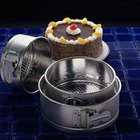Rikanapat/iStock/GettyImages
If you're wondering, "Can pasta be frozen?" the answer is "definitely." Dry pasta that you buy in a store doesn't need to be frozen if you intend to use it within the next three years. However, if you made the pasta yourself, freezing will extend the shelf life of your efforts from five days to eight months.
Freezing Store-Bought Dry Pasta
You won't hurt store-bought pasta by freezing it if you are trying to reduce empty airspace in your freezer to save money. Put the pasta in a freezer bag, and wrap the package in freezer paper or aluminum foil to prevent ice crystals from forming and prevent your pasta from becoming discolored or absorbing freezer odors. If you aren't trying to take up freezer space, maximize pasta life at room temperature by keeping it in an airtight container or resealable zipper bag.
Freezing Homemade Dry Pasta
Place homemade pasta on a drying rack after cutting, and let it dry uncovered for 12 to 24 hours. Circulating air around the pasta with a fan can help remove moisture. You'll know when the pasta is dry enough when it snaps as you twist it instead of bending before it breaks. Place the pasta in a single layer on a cookie sheet, and put it in the freezer for about 15 minutes. The pasta shouldn't stick to the cookie sheet or other pasta; if it does, return it to the freezer for another 5 to 10 minutes.
At this point, you can put the pasta in freezer bags and store it in your freezer for up to three months. Wrap the bag of pasta with freezer paper to extend freshness and usability for up to eight months.
Freezing Dry Pasta in an Assembled Dish
Use dry pasta to make freeze-ahead lasagna, ziti or another pasta dish that transitions from freezer to oven for an easy meal. Simply layer your uncooked pasta, sauce, beef and ricotta cheese mixture in two to three layers, and freeze. For stuffed pasta such as manicotti or stuffed shells, pour a cup of a half-and-half mix of spaghetti sauce and water on the bottom of the pan prior to placing the stuffed uncooked pasta in the pan. Cover and freeze.
When you're ready to cook it, take the casserole out of the freezer the night or morning before, and thaw it partially in the refrigerator. Let the lasagna or pasta casserole sit on the counter while your oven heats to 350 degrees, or about 30 minutes, before baking through until the center reaches 165 degrees.
Related Articles

How to Make Homemade Mac & Cheese

How to Cook Fresh Pasta Dough

How Long Is Fresh Pasta Supposed to Dry ...

How Long Can You Refrigerate Nacho ...

How to Make Lasagna Pie in a Springform ...

Does Bread Expire?
How Long Will Uncooked Pasta Keep in ...

Baked Pasta With Cottage Cheese

How Do I Freeze Stuffed Shells?

Calories in 1 Cup of Pasta Primavera

How to Cook Wild Rice in the Oven

How to Reheat Lasagna

How to Freeze Stromboli

How to Fry Raw Spaghetti
Freezing a Dish With Sour Cream in It

Easy Meals That Stretch Days
Easy Tuna Noodle Casserole Recipe

Make-Ahead Lasagna Tips

How to Freeze Baklava

How to Cook & Freeze Spaghetti Noodles
References
- EatByDate: How Long Does Pasta Last?
- How Stuff Works: 5 Ways to Fill YOur Freezer for Efficiency
- Still Tasty: Food Storage - How Long Can You Keep Spaghetti, Dry, Uncooked
- The Kitchn: Cooking Pasta Without the Stove
- King Arthur Flour: Homemade Pasta – Six Tips for Success
- Reynolds Kitchens: Freezer Paper
- Taste of Home: Make Ahead Spinach Manicotti
- Plan to Eat: Lasagne from the Freezer
Resources
Writer Bio
Indulging her passion for healthy living and fitness through the written word on a full-time basis since 2010, former health coach, fitness instructor and world-class athlete Jodi Thornton-O'Connell guides readers to discover fun and delicious ways to physically connect to their surroundings.